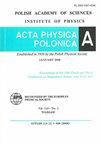Vertex Simulation of Grain Growth in the Presence of Zener Pinning Effect
IF 0.5
4区 物理与天体物理
Q4 PHYSICS, MULTIDISCIPLINARY
引用次数: 0
Abstract
In this study, we investigated the pinning effect exerted by second-phase particles on grain growth. To overcome the difficulties, mainly linked to the complex topological events while using the standard vertex technique in the presence of particles, a modified version of grain growth simulation is presented. The simulation is based on input data from electron backscatter diffraction measurements. Two hexagonal lattices discretize the physical space. One grid stores the grain orientation data, i.e., Euler’s angles ( ϕ 1 , ϕ, ϕ 2 ) . Nodes (vertices) are located in the second grid, where particles are randomly distributed. Vertex simulations, by mean triple junctions dynamics only, were performed to highlight the influence of the surface fraction of the particles on the grain size distribution, the limiting mean grain size, and the edges per grain distribution. During the simulation procedure, vertices move in the direction of the effective force, which results from the driving and the pinning forces.齐纳钉扎效应下晶粒生长的顶点模拟
在本研究中,我们研究了第二相颗粒对晶粒生长的钉住作用。为了克服在粒子存在时使用标准顶点技术时主要与复杂拓扑事件相关的困难,提出了改进版本的晶粒生长模拟。模拟是基于电子后向散射衍射测量的输入数据。两个六边形晶格使物理空间离散化。一个网格存储颗粒方向数据,即欧拉角(ϕ 1, ϕ, ϕ 2)。节点(顶点)位于第二个网格,其中粒子是随机分布的。顶点模拟仅通过平均三结动力学进行,以突出颗粒的表面分数对晶粒尺寸分布、极限平均晶粒尺寸和每晶粒分布的边缘的影响。在仿真过程中,顶点的运动方向与有效力的方向一致,这是驱动力和钉住力共同作用的结果。
本文章由计算机程序翻译,如有差异,请以英文原文为准。
求助全文
约1分钟内获得全文
求助全文
来源期刊

Acta Physica Polonica A
物理-物理:综合
CiteScore
1.50
自引率
0.00%
发文量
141
审稿时长
6 months
期刊介绍:
Contributions which report original research results
and reviews in the fields of General Physics, Atomic and
Molecular Physics, Optics and Quantum Optics, Quantum Information, Biophysics, Condensed Matter, and
Applied Physics are welcomed.
 求助内容:
求助内容: 应助结果提醒方式:
应助结果提醒方式:


